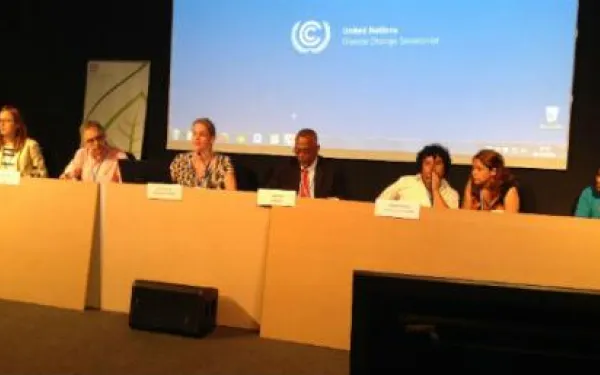Human rights in the new climate agreement: Tomorrow will be too late
Observing the UN Climate Negotiations is like entering another world. Governments, organizations and individuals advance their agendas, and all are discussed simultaneously: mitigation, adaptation, financing, Intended Nationally Determined Contributions (INDCs), loss and damages, common but differentiated responsibilities, and many other matters. The common objective is making binding commitments to tackle climate change. As a member of AIDA’s team, together with my colleagues Andrea Rodríguez and Víctor Quintanilla, I participated last December in the 20th session of the Conference of Parties of the United Nationals Framework Convention on Climate Change (COP 20) in Lima, Peru. Being there was an incredible learning experience. The Conference was two weeks of intense negotiations, even more so in the final days, intended to pave the way for the new binding climate agreement that will be adopted at the UN Climate Conference in Paris later this year. The result was the Lima Call for Climate Action, a document approved in overtime hours as an emergency measure so that the meeting did not conclude without an agreement. The document has been much written about, touted by some as a great success and by others as a failure. I would simply like to point out that a key point is missing from the Lima appeal: the recognition that climate change interferes with the enjoyment of human rights. Not for lack of trying. Mary Robinson, the former United Nations High Commissioner on Human Rights, who is now the Secretary General’s Special Envoy for Climate Change, warned that climate change is "the greatest human rights issue of the 21st Century." Photo: Máximo Ba Tiul presents the case of the Santa Rita hydroelectric project in an event during the COP20. Credit: AIDA. Experts and UN rapporteurs have asked States that are part of the Framework Convention to include in the coming agreement specific language stating that all parties must, in all climate change related actions, promote, protect, respect and fulfill with the human rights of all people. These are the words written by 28 experts and special rapporteurs to the UN in an open letter sent on October 17, 2014. Also, more than 70 independent experts and UN special rapporteurs also called for this recognition on December 10, International Human Rights Day. AIDA and colleague organizations have been insisting not only that the new climate agreement should incorporate comprehensive and operative language on human rights, but also that the actions taken to mitigate climate change respect human rights. Amidst the technicalities and the negotiations, I saw the human face of climate change. During the Lima Conference, I met Máximo Ba Tiul, an indigenous Maya Poqomchi from Guatemala and the representative of the Tezulutlán Peoples Council. Máximo participated in a variety of activities during the Conference, carrying with him the message of the indigenous peoples affected by the Santa Rita dam, a project registered under the Clean Development Mechanism (CDM) of the Convention. Through the Mechanism, industrialized countries may obtain carbon credits by implementing emission-reduction projects in developing countries. The problem is that many of these projects have caused human rights violations. For example, the Guatemalan government neither consulted with nor obtained the free, prior, and informed consent of the affected indigenous communities before authorizing Santa Rita. Furthermore, security forces have harassed communities that oppose the dam and charged opposition leaders as criminals. Violence and repression have escalated: a worker from the company murdered two children, David, 11, and Ageo, 13, in August 2013. In August 2014, the violence flared. More than a thousand state agents raided the area and attacked community members, among them pregnant women, the elderly, and children, who were all forced to flee. Photo: Machinery beginning the dredging of the Dolores River for the construction of the Santa Rita Dam at the end of 2011. Credit: Community Archive. The Santa Rita hydroelectric project has clearly led to human rights violations, which continue to this day. Crime, violence, and harassment remain unpunished. The project continues to hold its certification from the Clean Development Mechanism. Going public at one of the Conference events, Máximo asked: Why do you have to violate human rights to mitigate the effects of climate change? The only response: silence. Cases like Guatemala’s Santa Rita dam, emblematic of many projects registered under the Clean Development Mechanism, remind us of the urgent need to incorporate human rights protection into all climate actions. Human rights protection must be binding in the new climate agreement to be approved in Paris. Otherwise, the defense of communities’ rights will be another fight lost in the fight against climate change. The time is NOW. Tomorrow will be too late!
Read more
